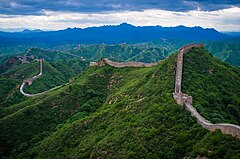
The Great Wall of China is a series of fortifications made of stone, brick, tamped earth, wood, and other materials, generally built along an east-to-west line across the historical northern borders of China to protect the Chinese states and empires against the raids and invasions of the various nomadic groups of the Eurasian Steppe. Several walls were being built as early as the 7th century BC these, later joined together and made bigger and stronger, are now collectively referred to as the Great Wall. Especially famous is the wall built 220–206 BC by Qin Shihuang, the First Emperor of China. Little of that wall remains. Since then, the Great Wall has on and off been rebuilt, maintained, and enhanced; the majority of the existing wall is from the Ming Dynasty.
Other purposes of the Great Wall have included border controls, allowing the imposition of duties on goods transported along the Silk Road, regulation or encouragement of trade and the control of immigration and emigration. Furthermore, the defensive characteristics of the Great Wall were enhanced by the construction of watch towers, troop barracks, garrison stations, signaling capabilities through the means of smoke or fire, and the fact that the path of the Great Wall also served as a transportation corridor.
The main Great Wall line stretches from Shanhaiguan in the east, to Lop Lake in the west, along an arc that roughly delineates the southern edge of Inner Mongolia. A comprehensive archaeological survey, using advanced technologies, has concluded that the Ming walls measure 8,850 km (5,500 mi) This is made up of 6,259 km (3,889 mi) sections of actual wall, 359 km (223 mi) of trenches and 2,232 km (1,387 mi) of natural defensive barriers such as hills and rivers. Another archaeological survey found that the entire wall with all of its branches measure out to be 21,196 km (13,171 mi).
Names
The collection of fortifications now known as "The Great Wall of China" has historically had a number of different names in both Chinese and English.
In Chinese histories, the term "Long Wall(s)" (長城, changcheng) appears in Sima Qian's Records of the Grand Historian, where it referred to both the separate great walls built between and north of the Warring States and to the more unified construction of the First Emperor.[7] The Chinese character 城 is a phono-semantic compound of the "place" or "earth" radical 土 and 成, whose Old Chinese pronunciation has been reconstructed as *deŋ.[8] It originally referred to the rampart which surrounded traditional Chinese cities and was used by extension for these walls around their respective states; today, however, it is much more often simply the Chinese word for "city".[9]
The name "Ten-Thousand-Mile Long Wall" (萬里長城, Wanli Changcheng) came from Sima Qian's description of it in the Records, though he did not name the walls as such. The AD 493 Book of Song quotes the frontier general Tan Daoji referring to "the long wall of 10,000 miles", closer to the modern name, but the name rarely features in pre-modern times otherwise.[10] The traditional Chinese mile (里, lǐ) was an often irregular distance that was intended to show the length of a standard village and varied with terrain but was usually standardized at distances around a third of an English mile.[11] Since China's metricization in 1930, it has been exactly equivalent to half a kilometer (500 meters or 1,600 feet),[12] which would make the wall's name describe a distance of 5,000 kilometers (3,100 mi). However, this use of wàn is figurative in a similar manner to the Greek and English myriad and simply means "innumerable" or "immeasurable".[13]
Because of the wall's association with the First Emperor's supposed tyranny, the Chinese dynasties after Qin usually avoided referring to their own additions to the wall by the name "Long Wall".[14] Instead, various terms were used in medieval records, including "frontier(s)" (塞, sāi),[15] "rampart(s)" (垣, yuán),[15] "barrier(s)" (障, zhàng),[15] "the outer fortresses" (外堡, wàibǎo),[16] and "the border wall(s)" (t 邊牆, s 边墙, biānqiáng).[14] Poetic and informal names for the wall included "the Purple Frontier" (紫塞, Zǐsāi)[17] and "the Earth Dragon" (t 土龍, s 土龙, Tǔlóng).[18] Only during the Qing period did "Long Wall" become the catch-all term to refer to the many border walls regardless of their location or dynastic origin, equivalent to the English "Great Wall".[19]
The current English name evolved from accounts of "the Chinese wall" from early modern European travelers.[19] By the 19th century,[19] "The Great Wall of China" had become standard in English, French, and German, although other European languages continued to refer to it as "the Chinese wall".[13]
![...:[ Барани]:...](http://bayanbox.ir/preview/5995511391536858096/baran2pic.com.jpg)